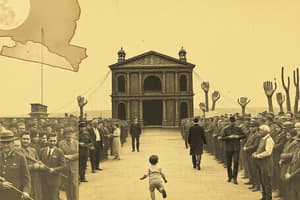Podcast
Questions and Answers
The past simple is used to describe ______ actions or events that happened at a specific time in the past.
The past simple is used to describe ______ actions or events that happened at a specific time in the past.
completed
We form the past simple using the base form of the verb + -ed for ______ verbs.
We form the past simple using the base form of the verb + -ed for ______ verbs.
regular
The past continuous is used to describe actions that were in ______ at a specific time in the past.
The past continuous is used to describe actions that were in ______ at a specific time in the past.
progress
The past continuous is formed using was/were + the present ______ of the verb.
The past continuous is formed using was/were + the present ______ of the verb.
Past continuous often sets the scene or describes an ongoing action that is interrupted by a past ______ event.
Past continuous often sets the scene or describes an ongoing action that is interrupted by a past ______ event.
I was eating dinner when you ______. This is an example of past continuous and past simple being used together
I was eating dinner when you ______. This is an example of past continuous and past simple being used together
While she was walking to school, it started to ______.
While she was walking to school, it started to ______.
The birds were singing, the sun was shining, and the children were playing in the park. This is an example of using past continuous for describing ______.
The birds were singing, the sun was shining, and the children were playing in the park. This is an example of using past continuous for describing ______.
The past continuous tense describes actions in ______ at a specific time in the past.
The past continuous tense describes actions in ______ at a specific time in the past.
Stative verbs describe states, feelings, or ______ rather than actions.
Stative verbs describe states, feelings, or ______ rather than actions.
The past simple tense describes ______ actions or events at a specific time in the past.
The past simple tense describes ______ actions or events at a specific time in the past.
To express annoyance about a repeated action in the past, the past continuous tense is often used with '______,' 'constantly,' or 'forever'.
To express annoyance about a repeated action in the past, the past continuous tense is often used with '______,' 'constantly,' or 'forever'.
'I was knowing the answer' is an ______ sentence because 'know' is a stative verb.
'I was knowing the answer' is an ______ sentence because 'know' is a stative verb.
When the doorbell rang, they ______ watching TV. (were/was)
When the doorbell rang, they ______ watching TV. (were/was)
While she was cooking dinner, he ______ doing his homework.
While she was cooking dinner, he ______ doing his homework.
Flashcards
Past Simple
Past Simple
Describes completed actions or events at a specific past time.
Past Continuous
Past Continuous
Describes actions in progress at a specific time in the past, focusing on duration.
Past Simple Formation
Past Simple Formation
Regular verbs: base form + -ed (e.g., walked). Irregular verbs: unique forms (e.g., went).
Past Continuous Formation
Past Continuous Formation
Signup and view all the flashcards
Completion vs. Duration
Completion vs. Duration
Signup and view all the flashcards
Specific Time (Past Continuous)
Specific Time (Past Continuous)
Signup and view all the flashcards
Interruption
Interruption
Signup and view all the flashcards
Describing Atmosphere
Describing Atmosphere
Signup and view all the flashcards
Past Continuous for Irritation
Past Continuous for Irritation
Signup and view all the flashcards
Stative Verbs
Stative Verbs
Signup and view all the flashcards
Mixing Up Tenses
Mixing Up Tenses
Signup and view all the flashcards
Incorrect Past Continuous Use
Incorrect Past Continuous Use
Signup and view all the flashcards
Combining Past Tenses
Combining Past Tenses
Signup and view all the flashcards
Study Notes
- The past simple and past continuous are both used to talk about the past, but they describe different kinds of actions and are often used together to provide context or create a narrative
Past Simple
-
Used to describe completed actions or events that happened at a specific time in the past
-
Focuses on finished actions, habits or states in the past
-
Often used with specific time expressions (e.g., yesterday, last week, in 2010)
-
Formation: Regular verbs: base form + -ed (e.g., walked, played); Irregular verbs: have their own past simple forms (e.g., went, saw, ate)
-
Examples:
- I visited Paris last year.
- She watched a movie yesterday evening.
- They lived in London for five years.
Past Continuous
-
Used to describe actions that were in progress at a specific time in the past
-
Focuses on the duration of an action rather than its completion
-
Describes background actions or situations, often interrupted by a past simple action
-
Formation: was/were + present participle (-ing form of the verb)
-
Examples:
- I was watching TV when the phone rang.
- They were playing football at 3 PM yesterday.
- She was studying all night.
Key Differences
- Completion vs. Duration: Past simple describes completed actions, while past continuous describes actions in progress
- Specific Time: Past simple can refer to a specific point in time or a period, while past continuous usually refers to a specific moment when the action was happening
- Interruption: Past continuous often sets the scene or describes an ongoing action that is interrupted by a past simple event
Using Past Simple and Past Continuous Together
-
Often used together to show that one action (past simple) interrupted another (past continuous)
-
The past continuous sets the scene or describes the background action, while the past simple describes the interrupting action
-
Examples:
- I was eating dinner when you called. (Eating dinner was in progress, and the phone call interrupted it)
- While she was walking to school, it started to rain. (Walking to school was ongoing, and the rain began during the walk)
- They were watching a movie when the power went out. (Watching a movie was in progress, and the power outage interrupted it)
Other Uses and Considerations
-
Past Continuous for Describing Atmosphere: Can be used to describe the atmosphere or background of a scene in the past
- Example: The birds were singing, the sun was shining, and the children were playing in the park.
-
Past Continuous for Repeated Actions (Irritation): Can express annoyance or irritation about a repeated action in the past
- Always used with "always," "constantly," or "forever"
- Example: He was always complaining about something.
-
Stative Verbs: Stative verbs (verbs that describe states, feelings, or opinions rather than actions) are generally not used in the continuous form
- Examples of Stative Verbs: know, believe, understand, like, hate, want, need
- Incorrect: I was knowing the answer.
- Correct: I knew the answer.
Common Mistakes to Avoid
-
Mixing Up Tenses: Ensure you use the correct form of the verb for each tense
- Incorrect: I was eat dinner when the phone rang.
- Correct: I was eating dinner when the phone rang.
-
Using Past Continuous for Completed Actions:
- Incorrect: I was visiting Paris last year.
- Correct: I visited Paris last year.
-
Incorrect Use of Stative Verbs:
- Incorrect: She was wanting a new car.
- Correct: She wanted a new car.
Practice Examples
-
Complete the sentences using the past simple or past continuous:
- I (walk) _______ to the store when I (see) _______ my friend.
- While she (cook) _______ dinner, he (do) _______ his homework.
- They (watch) _______ TV when the doorbell (ring) _______.
-
Answers:
- I was walking to the store when I saw my friend.
- While she was cooking dinner, he was doing his homework.
- They were watching TV when the doorbell rang.
Summary
- Past Simple: Describes completed actions or events at a specific time in the past
- Past Continuous: Describes actions in progress at a specific time in the past, often interrupted by a past simple action
- Using them together helps provide context, describe background actions, and show interruptions
- Avoid common mistakes such as mixing up tenses or misusing stative verbs
Studying That Suits You
Use AI to generate personalized quizzes and flashcards to suit your learning preferences.




